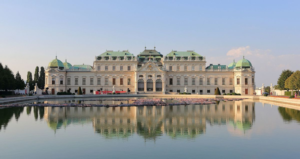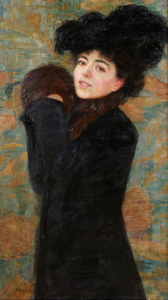During our latest excursion to Vienna, we were able to explore the luxurious Belvedere, the former palace of Prince Eugene of Savoy. The first moment I saw the Upper Belvedere, I began to realize the extent of how extravagant the lives of the Habsburgs were. Both the Lower and Upper Belvedere palaces were constructed by the Baroque architect Johann Lucas von Hildebrandt as a summer residence for Prince Eugene. Like other Baroque architecture, the Upper Belvedere has several grandiose domes and an elegant white facade with golden trimmings that are meant to impress visitors like me.
Within the Upper Belvedere palace is an art museum that showcases impressive art pieces from the Middle Ages to present, focusing on Viennese Artists such as Gustav Klimt, a founding member of the Viennese secession art movement. The most famous of his works is the oft photographed but nevertheless beautifully ornamented Kiss, which like many of his other works, doesn’t have a concrete meaning or purpose. As someone who is not well versed in art history, our tour guide did an excellent job giving historical context to each of the paintings. This historical experience allowed me to form a deeper connection with each individual art piece, such as how Carlo Carlone painted beautiful mural of Mars on the ceiling of the massive Marble room in order to demonstrate the military prestige of his patron, Prince Eugene.
Almost every art piece in the museum hangs in a lofty Baroque interior. These interiors are just as impressive as the outside of the Upper Belvedere, with many carved and painting ceilings. I observed that many of these illustrations seemed to be of Greek gods and goddesses like Mars and Athena, which I thought was odd considering the deep connections the Habsburgs had with the Catholic Church. I asked our tour guide about this oddity, and she noted that Greek mythology often appears in Baroque and architecture because of the prestige and power that it represents. The view from the third floor of the palace also offers a stunning view of the Lower Belvedere and the skyline of Austria.
The Lower Belvedere is a much comparatively more modest Baroque building, as it served as an actual residence while the Upper Belvedere served to display prestige. It was built between 1712 and 1717 in conjunction with the installation of the neighboring gardens. The gardens themselves are picturesque with several marble sculptures and fountains, as well as carefully trimmed hedges and trees. After entering the Lower Belvedere from the gardens, I was able to walk two much smaller but still impressive exhibitions focusing on the art of the modernist movement and works of art created during Maria Theresa’s rule. The former exhibition includes key works by Austrian and Croatian artists of the early 20th century such as Robert Auer’s portrait of artist’s wife, while the latter had a wide variety of art that often had some connection to the Habsburg family, such as Daniel Schmidley’s portrait of Maria Theresa. All in all I was able to see a large and varied collections of artwork with incredible historical insight.
Maria Theresa in Hungarian Coronation Dress by Daniel Schmidley
Portrait of an Artist’s Wife by Robert Auer


